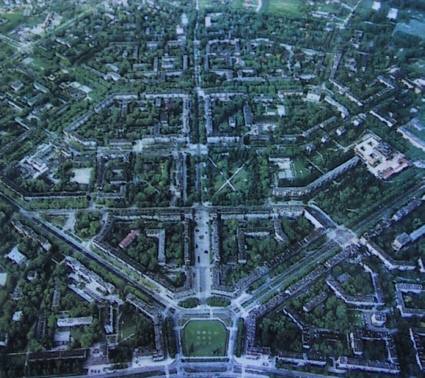Amongst its pages on the Krakow, the book mentions a place called Nowa Huta, describing it as 50s 'social engineering experiment' that is now 'a troubled district...that fascinates with its grandiose Stalinist architecture'. As a high-risk tourism venture goes, it's up there with London advertising 'Come to Norwood Junction - it's edgy. There are chicken bones. Mmm'. But, having nearly collected the full set of English 50s New Towns, I thought I'd take the opportunity to see how the Socialists did urban planning back then.
The whole settlement of Nova Huta was inflicted on the middle-classes of Krakow, for their refusal to vote for Uncle Vladimir in a post-war referendum. The idea was to balance out the vile Krakowiak bourgeois with some honest-to-goodness salt-of-the-earth Workers. Hence the New Town was focused on a steel works - a vast complex, which once held the largest blast furnace in Europe.
The receptionist at the hotel was clearly somewhat dismayed that I was asking how to get to Nowa Huta, rather than the walled charms of the Old Town. She told me I could catch a tram directly Howa Huta, but was unable to tell me how I'd know when I'd actually reached there...
So I got off the tram sort-of at random, on the basis that I had passed the picturesque kitsch of the Old Town some time ago (and a couple of really horrid PoMo shopping centres). I could see some post-war 50s-ish buildings, so hoped I might be in the right sort of area. These point blocks look distinctly similar to the medium-rise things we have dotted around the UK (particularly now they're adorned with satellite dishes). So far, so not very exciting.
'...grandiose Stalinist...'?
That's my shadow in the bottom right.
I appear to be saluting.
This aerial shot shows the design of the development - with the Plac at the bottom, the main avenues fanning out, with housing blocks filling up the spaces in betweeb.
Copyright: teh internets
I mentioned before how social and political ideas are so often manifested in the buildings of the time. For example, English New Towns like Welwyn Garden City were built with swathes of trees and parks as a reaction to the dense slum housing of the industrial revolution, to enhance the quality of life for the residents. As an added bonus, and quite terrifyingly, the greenery of Nova Huta was included to help soak up the radiation from the feared nuclear war; the wide streets would prevent the spread of apocalyptic fires; and the layout of the housing blocks meant that the city could be turned into a walled fortress with comparative ease. Serious stuff.
According to a slim volume I later bought from the one-room Howa Huta Museum, these blocks were originally pretty dismal inside, with 'no central heating, no sewage system...the floors were simply lined with bare, unplaned planks'. That said, in the setting wintery sun, the blocks looked a little like the cute pastiche of somewhere like Welwyn (although, as if the punchline to a Victoria Wood skit, rather than a whopping great steel plant, Welwyn had a Shredded Wheat factory). Presumably completing the aims of this design, the outside of the blocks looked quite attractive to a Prole like me.
Off to the east of the main housing matrix lies the eponymous steel works, its huge on-stilts signage rising up from the trams' power cables. From a distance, it looks a bit like Croydon's Ikea.
Ampere Way, Communist style
The administrative blocks standing of either side of the sign are topped with a comb attic of renaissance details, nodding to the fluted stylings of the Old Town buildings. The steel works - apparently still in operation - are closed off behind some gates.
Amazing bit of sans serif on dynamic stilts.
Broken ice floated on the surface of the Nowa Huta lake, as I headed back towards the warmth of the hotel. It was cold.







No comments:
Post a Comment